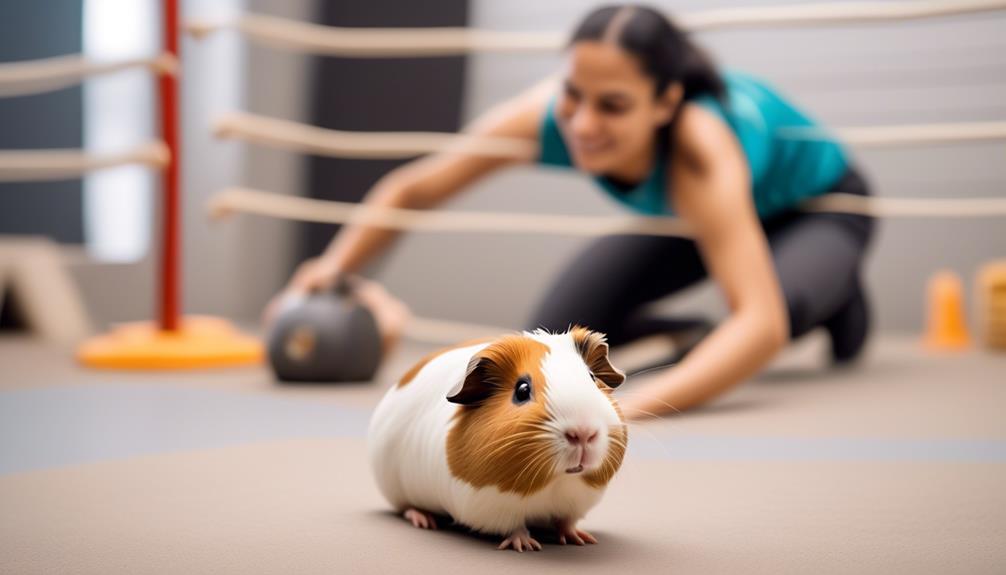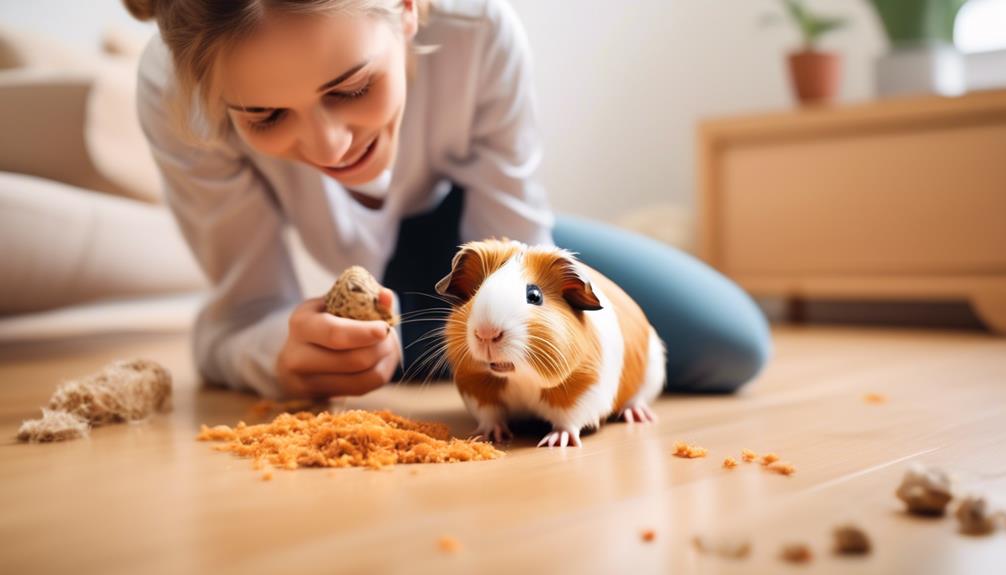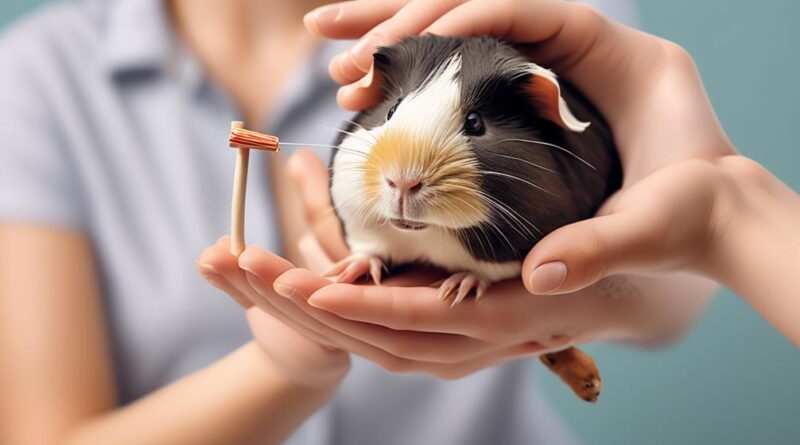Starting Your Journey: 4 Tips for Guinea Pig Training
If you've ever thought that training a guinea pig is impossible because of their small size or skittish nature, think again. With the right approach and techniques, guinea pig training can be a rewarding journey for both you and your furry friend.
You may be surprised to learn that guinea pigs are intelligent and can be trained to respond to commands and cues.
So, how exactly can you start training your guinea pig? Well, we've got four essential tips that will set you on the path to successful guinea pig training.
Understanding Guinea Pig Behavior
How can you understand your guinea pig's behavior and communicate with them effectively? Understanding guinea pig communication and the social hierarchy in guinea pigs is key to building a strong bond with your furry friend.
Guinea pigs are social animals that communicate through a variety of vocalizations, body language, and behavior. By observing these cues, you can gain valuable insights into their feelings and needs.
Guinea pigs establish a social hierarchy within their group, which can also be observed in their interactions with humans. They may display dominance by nudging, mounting, or chasing other guinea pigs or even your hand. Understanding this behavior can help you respond appropriately, ensuring that they feel secure and respected in their interactions with you.
When communicating with your guinea pig, pay attention to their vocalizations such as squealing, purring, and chutting, as these can indicate excitement, contentment, or distress. Additionally, observe their body language, including ear and whisker positions, to gauge their mood and level of comfort. For instance, a guinea pig with raised hackles may be feeling threatened or agitated.
Creating a Training-Friendly Environment
To establish a training-friendly environment for your guinea pig, it's essential to consider their social hierarchy and communication cues, ensuring they feel secure and respected during the training process. Start by creating a training plan that's tailored to your guinea pig's individual personality and needs. This plan should include specific goals, such as teaching them to respond to their name or to use a litter box, and break down the training into small, manageable steps.
Consistency and patience are key; guinea pigs thrive on routine, so sticking to a regular training schedule will help them feel secure and confident in their environment.
Encouraging exploration is another crucial aspect of creating a training-friendly environment. Provide your guinea pig with a spacious and enriching living space that includes hiding spots, tunnels, and toys to stimulate their curiosity. Allowing them to explore and interact with their environment won't only keep them mentally and physically active but also build their confidence, making them more receptive to training.
In addition to physical surroundings, consider the emotional environment. Ensure that your guinea pig feels safe and loved by providing gentle and positive interactions. Offer treats, praise, and gentle pets as rewards during training sessions to reinforce positive behaviors and strengthen the bond between you and your pet.
Positive Reinforcement Techniques
When training your guinea pig, utilize positive reinforcement techniques such as offering treats and praise to reinforce desired behaviors. Positive reinforcement is a powerful tool that can help your guinea pig understand what behaviors you want to encourage.
Here are three effective positive reinforcement techniques to implement in your guinea pig training:
- Using Clicker Training: Clicker training is a popular positive reinforcement technique for guinea pigs. By associating the sound of a clicker with a treat, you can effectively communicate to your guinea pig when they've performed the desired behavior. This method helps to create a clear and consistent signal for your guinea pig to understand which behaviors are being reinforced.
- Shaping Behavior: Shaping behavior involves breaking down a desired behavior into smaller achievable steps. By rewarding each incremental progress towards the final behavior, you can effectively shape your guinea pig's actions. This technique is particularly useful for teaching complex behaviors or tricks to your guinea pig.
- Introducing New Stimuli and Rewarding Desired Behavior: When introducing new toys, environments, or experiences to your guinea pig, use positive reinforcement to help them feel comfortable and confident. Rewarding your guinea pig for exploring and interacting with new stimuli encourages them to be curious and adaptable.
Incorporating these positive reinforcement techniques into your guinea pig training regimen can help foster a strong bond and effective communication between you and your pet.
Building Trust and Bonding
To build trust and foster a strong bond with your guinea pig, consistently spend time interacting with and gently handling them. Establishing routines is crucial in building trust and confidence in your guinea pig. Regular interaction will help your guinea pig become accustomed to your presence and touch, allowing them to feel more at ease and secure in your company.
Start by setting up a daily routine that includes regular feeding times, playtime, and handling. Guinea pigs thrive on predictability, so establishing a consistent schedule will help them feel secure and build confidence in their interactions with you. When interacting with your guinea pig, speak to them in a calm and soothing voice to help them feel reassured and comfortable in your presence.
In addition to routine interactions, it's important to create a safe and comfortable environment for your guinea pig. Provide them with a cozy and secure living space, plenty of fresh hay, and stimulating toys to keep them entertained. Building a comfortable environment will help your guinea pig feel secure and content, strengthening the bond between you.
Regular handling is also essential in building trust with your guinea pig. Start by gently petting and holding them for short periods each day, gradually increasing the duration as they become more comfortable. Always approach your guinea pig calmly and avoid sudden movements to help them feel at ease in your presence. Consistent, gentle handling will help your guinea pig build confidence and trust in your interactions, ultimately strengthening the bond between you and your furry friend.
Setting Training Goals

As you continue to build trust and bond with your guinea pig through consistent interactions and a comfortable environment, it's important to set clear training goals to further enhance your relationship and their skills. Understanding guinea pig behavior is crucial in setting achievable training goals. Consider their natural tendencies and preferences when determining what behaviors or tricks you want to train them in. This not only ensures that the training goals are realistic but also helps in creating a positive and enriching experience for your guinea pig.
Training progress tracking is essential for both you and your guinea pig. It allows you to see the gradual improvement and celebrate the small victories, which can be incredibly rewarding. It also helps in identifying any challenges or areas where your guinea pig may need additional support or modified training techniques. This process fosters a deeper connection as you work together towards achieving these goals.
Setting training goals also provides mental stimulation for your guinea pig. This can lead to increased confidence and a stronger bond between you and your furry friend. When they successfully accomplish a training goal, it's a moment of joy and pride for both of you, strengthening your relationship and creating a sense of accomplishment.
Handling and Socializing Tips
For successful handling and socializing with your guinea pig, gentle and consistent interaction is essential to build trust and comfort. Socialization techniques are crucial in helping your guinea pig feel at ease around you. Start by spending time near your guinea pig's cage, speaking softly and offering treats to associate your presence with positive experiences. Once your guinea pig seems relaxed, you can begin taming methods by offering your hand for them to sniff and gently stroking their back when they allow it. It's important to be patient and move at your guinea pig's pace, as forcing interactions can lead to fear or stress.
When handling your guinea pig, always approach them calmly and avoid sudden movements. Support their body with both hands to make them feel secure and minimize the risk of them squirming or jumping out of your grasp. If your guinea pig becomes anxious or tries to escape, gently return them to their cage and try again later. Consistency is key in building trust and helping your guinea pig become more comfortable with handling.
Regular socialization and handling will help your guinea pig become more accustomed to your presence, making interactions more enjoyable for both of you. By using these taming methods and socialization techniques, you can create a strong bond with your guinea pig based on trust and mutual respect.
Addressing Common Training Challenges

Dealing with common challenges in training your guinea pig requires patience and understanding of their unique behaviors and instincts. It's important to remember that each guinea pig is an individual with its own personality and quirks.
Here are some tips to help you navigate through common training challenges:
- Training Schedule: Establishing a consistent training schedule is crucial for guinea pig training. These small animals thrive on routine and predictability. By setting aside specific times for training sessions, you can help your guinea pig feel more comfortable and receptive to learning. Remember to keep the sessions short and sweet, as guinea pigs have short attention spans.
- Behavior Modification: When faced with behavioral challenges such as biting or resistance to handling, it's essential to approach the situation with patience and understanding. Positive reinforcement techniques, such as offering treats and praise, can be effective in modifying unwanted behaviors. Additionally, understanding the root cause of the behavior, whether it's fear or discomfort, can help you address and modify it more effectively.
- Consistency and Patience: Consistency is key in guinea pig training. It's important to remain patient and persistent, even when faced with setbacks. Guinea pigs may take time to adjust to new commands or behaviors, so it's crucial to stay consistent with your training methods and to celebrate small victories along the way.
Consistency and Patience in Training
Establishing a consistent training routine for your guinea pig is crucial for promoting learning and positive behavior. Consistency and patience are key when it comes to training your little friend. Training progress can be slow at times, but with patience and a consistent approach, your guinea pig will gradually start to pick up on behavioral cues.
When it comes to training progress, it's important to remember that every guinea pig is unique and will learn at their own pace. Some may catch on quickly, while others may take more time to grasp certain commands or behaviors. This is where patience becomes essential. Avoid getting frustrated if your guinea pig doesn't respond immediately. Instead, continue to provide gentle guidance and positive reinforcement.
Consistency is equally important. Try to schedule training sessions at the same time each day, as this will help your guinea pig understand what to expect and when to expect it. Using consistent cues and commands will also aid in their understanding of what's expected of them. For instance, if you're teaching your guinea pig to come when called, using the same verbal cue each time will reinforce the behavior.
Frequently Asked Questions
Can Guinea Pigs Be Trained to Do Tricks Like Dogs or Other Pets?
Yes, guinea pigs can be trained to do tricks using clicker training and positive reinforcement.
Target training and shaping behavior are effective methods for teaching tricks.
With a clicker and some tasty treats, you can train your guinea pig to perform various tricks, such as spinning in a circle or jumping through a hoop.
How Long Does It Typically Take to Train a Guinea Pig to Respond to Commands?
Typically, it takes some time to train a guinea pig to respond to commands. The training progress can vary depending on the individual guinea pig's personality and your consistency in training. Some guinea pigs may pick up commands quicker than others.
With patience and positive reinforcement, you can expect to see results in a few weeks to a couple of months. Keep practicing and rewarding their good behavior to reinforce their training.
Can Guinea Pigs Be Potty Trained?
Yes, guinea pigs can be potty trained! You can teach them to use a litter box, which can help minimize indoor accidents.
Start by placing the litter box in their cage and putting some soiled bedding in it to encourage them. Clean up any accidents outside the box promptly, and be patient as they learn.
With consistent training, many guinea pigs can be successfully potty trained.
Are Certain Breeds of Guinea Pigs Easier to Train Than Others?
Certain breeds of guinea pigs may have different levels of receptiveness to training due to their behavioral differences. While some breeds may be more naturally inclined to pick up on training cues, all guinea pigs can benefit from consistent and positive training methods.
It's important to consider individual personality traits and adapt training techniques to suit each guinea pig's unique needs. With patience and understanding, you can overcome any training challenges regardless of breed.
Can Guinea Pigs Be Trained to Walk on a Leash?
Yes, guinea pigs can be trained to walk on a leash. Leash training allows for outdoor exploration while bonding and trust building.
Start by getting your guinea pig used to wearing the harness indoors before moving outdoors.
Use positive reinforcement with treats to encourage walking on the leash.
It's important to be patient and consistent as you gradually introduce your guinea pig to leash walking.
Conclusion
Now that you have the tools and tips for training your guinea pig, remember to be patient and consistent. Building trust and bonding with your pet is key to successful training.
Keep practicing positive reinforcement techniques and setting achievable training goals. With time and dedication, you'll see progress and develop a strong bond with your furry friend.
Enjoy the journey of training your guinea pig and cherish the special moments you share together.
